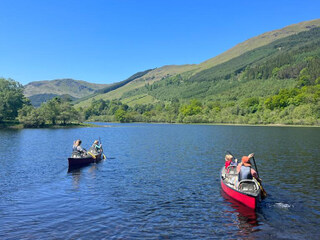Cycling
Wherever you go in Scotland , mountain biking and cycling on forest trails, paths or cycle routes is a great way of seeing the best of the scenery. In the Loch Lomond and The Trossachs National Park you can find excellent routes on purpose built cycleways and forest trails. If you’re fit enough you can even bike to the top of some serious mountains. Cycling in the Trossachs will suit all tastes and all levels of fitness.
Bikes can be hired on an hourly or daily basis from several cycling centres, two of which are in Callander, and one at Loch Katrine in the heart of the Trossachs.
Waymarked Cycle Routes
Forest Enterprise has way-marked cycle routes in many of it’s woodlands within the park boundary. The Lowland Highland Trail, part of National Cycle Network Route 7, passes through the park. It runs between Killin in the northeast and Drymen in the south, via Glen Ogle, Lochearnhead, Strathyre, Callander, Aberfoyle and Gartmore. The route uses forest tracks, traffic-free trails and minor roads and is regarded as one of the highlights of the National Cycle Network.
Trossachs Scotland – Cycle Routes
NEW - Trossachs Trail cycling routes at www.trossachstrail.co.uk
There are three main cycle routes in the Trossachs:
- The C7 Cycleway – Milngavie to Killin
- Loch Katrine route – bike and steamer
- The Glenfinglas route – arduous route
The National Park has options for all kinds of cycling; from short hour-long rides to full scale long distance touring; on-road, off-road or on dedicated cycle tracks by Loch, through forests and on mountain tracks. Some routes reach considerable altitudes and weather can change unexpectedly so it's important to be prepared.
Although the bike hire centres / shops will be able to help out if you have a problem with your bike it’s worth remembering that many of the cycle routes reach places which are fairly inaccessible by car and often miles from the nearest road. For this reason you should make sure you have at least a basic repair kit with you in order to avoid a long walk to the nearest road for help.
Kit to consider:
- Spare inner tube and puncture repair kit.
- Multi toolkit.
- High pressure pump.
- Small plastic bottle of general lube.
- Selection of cable ties – useful for repairs.
- Your bicycle flask.
- Some food, one or two snacks or a flask of soup.
- Suitable waterproofs and spare layers of clothing.
- Basic first aid kit.
- A mobile phone (although a signal may be unavailable in some areas).


